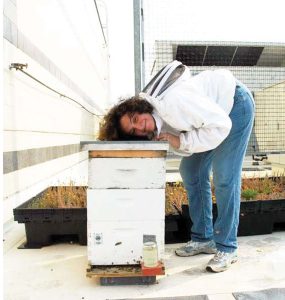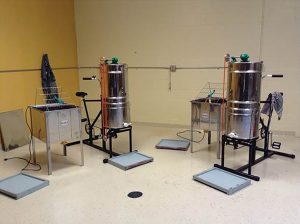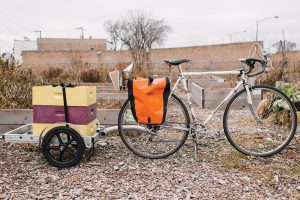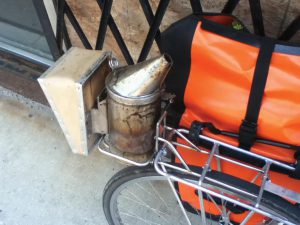Car-Free Beekeeping: Going Green Without Burning Gas
Human Powered Transit
By: Toni Burnham
 For the past few years, we have seen a small, but serious, handful of new beekeepers in our short courses who opt to take on beekeeping without personal, gas-powered transportation. Here in DC, they mostly do this by our public transit system, Metro. In fact, the White House beekeeper, Charlie Brandts, brought the (probably) most famous swarm in the world home by train on April 9, 2009 – there are feral colonies in the trees across the street from 1600 Pennsylvania Avenue, and one of them threw a swarm onto the pad where all the reporters stand when you see news stories with the mansion in the background. On the flip side, a couple of years ago an amateur swarm catcher in London brought a leaky box of bees onto one of those lovely double decker buses, and abandoned the project in a panic, causing the bus to be evacuated, the press again to get excited, and more experienced souls to arrive and clean up. Clearly, some guidance is a good idea.
For the past few years, we have seen a small, but serious, handful of new beekeepers in our short courses who opt to take on beekeeping without personal, gas-powered transportation. Here in DC, they mostly do this by our public transit system, Metro. In fact, the White House beekeeper, Charlie Brandts, brought the (probably) most famous swarm in the world home by train on April 9, 2009 – there are feral colonies in the trees across the street from 1600 Pennsylvania Avenue, and one of them threw a swarm onto the pad where all the reporters stand when you see news stories with the mansion in the background. On the flip side, a couple of years ago an amateur swarm catcher in London brought a leaky box of bees onto one of those lovely double decker buses, and abandoned the project in a panic, causing the bus to be evacuated, the press again to get excited, and more experienced souls to arrive and clean up. Clearly, some guidance is a good idea.
But beekeeping by shared or human-powered means of transit is not how I manage and mentor, and the next time we teach, I wanted to be able to offer better information for new students who need or want to do this for economic, geographical, philosophical, or any number of other reasons. Almost every beekeeper has a fairly personal set of goals for learning and practicing apiculture: these folks have a few more on top. Finally, over and over in urban beekeeping, we discover that beekeepers independently come up with similar and supporting ideas, but don’t know anyone else is doing it. (Consider me one of the most guilty!) This article is a shout out to all the cool souls who shared their experiences here, but also an invitation for the people we didn’t find to get in touch and share.
It also turns out that this might not be a good fit for every city. I contacted friends and associations in Atlanta, Pittsburgh, and San Francisco to seek out stories from those habitats, and it turns out that infrastructure, climate, and geography matter a lot. In both Pittsburgh and Atlanta, car-friendly urban settings, including infrequent or non-existent public transit to many areas, roads that leave little room for bikes, or lots of hills have reduced enthusiasm for beekeeping by alternative transport. The San Francisco Bee-Cause (www.sfbeecause.com), which has invested a lot of time and energy in a Bee Farm, finds that none of its members are getting there by bike or bus. Co-founder Karen Peteros mentions, “You gotta have good onsite storage,” a theme mentioned by most who undertake car-free apiculture. She adds “Our site is infested with Argentine ants. As a result, we are in a constant battle to keep them out of our hives and cannot store our hive equipment [there] . . . Instead, I have to store all the equipment at my house and lug it up and down my 22 stairs to and from my car.”

BeezKneez turned to their bike mechanic, Carl, to convert a broken donated extractor into a
pedal-powered dynamo. (photo credit: BeezKneez)
Non-car beekeepers seem to fall into two groups: folks who are managing apiaries by bike, and those who are using a combination of public transit resources. There are important advantages and challenges – not obstacles – to both. Bike beekeepers Jana Kinsman (bikeabee.com) of Chicago and Kristy Lynn Allen (www.thebeezkneezdelivery.com) of Minneapolis have great experiences and advice for folks looking at two-wheeled beekeeping, public transit beekeepers Justyna Nicinska of DC and Jim Fischer (NYCBeekeeping.org) of New York have explored the ins and outs of trains and buses, and Arielle Kouffman, also of Washington, is transitioning from the bus to pedal power.
Car beekeeping is lazy in many ways: you can just heave anything you can fit into the car, and proceed with just a hazy idea of what the bees might need or of how to structure the work you need to do into the time, season, and bee situation available. You can get away with not planning, not keeping good records, and not inventorying the mount of junk you keep on hand. This is the inverse of what anyone who is carrying their tools in a backpack, a bike basket, a grocery cart, or a bike trailer has to do.
Common themes for all means of transit
Planning is absolutely the key when the work you can do is limited by the amount you can carry. Every one of the beekeepers interviewed for this article talked about keeping track of the bees’ needs and the likely activities of the season, of important concerns like swarm prevention, feeding, and the inevitable unanticipated curve ball that living things will always throw. They all talk about keeping decent records, and taking a moment before they head out to calculate, as exactly as possible, what they will need and how they will get it there. In many ways, this is urban beekeeping on overdrive: in the city, we always have to worry a little bit more about how what we do impacts lots of people and bees: these folks have do all that, at that high quality, with great precision and care.
They all also point out that, a large part of the time, you can look after your bees with a veil, a tool and a smoker. But take that moment, collect your thoughts, and collect your stuff: then be a mindful beekeeper.
Time is a major consideration: for many apiary sites, a distance that looks trivial in a car takes on new significance with a super and a bag of sugar in tow. Justyna knew from the outset that she was not going to have access to a car, and got an apiary site in a community garden 1.1 miles from her house: a single mile that is downhill one way, uphill the other. She is bus dependent, but no purist. If the load is heavy, she might take a cab or phone a friend. But mostly, “I get into my beekeeping clothes and load up my grocery cart, and head for the bus stop. I look like a bag lady a lot of the time, and it is also important to know the bus schedule and how much time it is going to take to get to the bus stop, and from the bus to the hives and back.” She notes that she often has to use public transit from work to home to get tools, the bus again to get to her apiary, and has to fight disappearing daylight in order to do what she plans in a weekday visit. “It’s not like I can work by flashlight.”
Arielle was offered a great hive site at a local university, but realized what would take 10 minutes in a car would take more than an hour by bike or bus, and opted instead for a site near a major bus route.

Jana’s work bike. (photo by Brent Knepper – www.brentknepper.com)
Conversely, Jana groups her hive sites and her bike travel schedule into different neighborhoods on different days, and can get around to several bee yards across brutal traffic in a fraction of the time a car could manage.
Kristy in Minneapolis adds, “The time factor is significant, and it depends on your priorities. If you are trying to run a business, and economics is a major goal, the time required to manage the number of hives you can handle with a bike might not work. But we have a different philosophy and seeking different things, like community outreach, and that time is worth spending.”
Justyna notes that her trips would be a lot easier if she had reliable, secure storage at her site, and it is important to have a way to make sugar water or wash her hands, even if she has to carry her own H2O. Kristy of BeezKneez sets up her equipment for the whole season on site, but is careful to advise that any comb that has contained honey needs to be sealed, and pest situations need to be watched. Jim Fischer of New York finds carrying a smoker around to be a problem on the 4, 5 or 6 Train, so he keeps one on every rooftop.
Both Jana and Kristy overcome some of these storage constraints by using high quality bike trailers. Kristy shares that she is a 5’3” 120 pound woman who routinely hauls over 200 pounds of stuff around town. She uses a heavy duty Surly long bed trailer capable of holding 300 pounds. Jana uses a heavy duty Bikes at Work trailer made in Ames, A and has modified her bike to add panniers that are instrumental for carrying sugar water. “Loading the trailer is like a game of Tetris, and its really fun. I’ve had loads of over 300 pounds!”
Out apiaries involve community outreach, which can help. Beekeepers in community gardens, parks, school yards are going to get questions, and folks like BeezKneez actually banked on this as part of their alternative transit beekeeping and honey delivery. They wear bee clothes and decorate their bikes to get noticed! People are intrigued, ask questions, become “friends of bees,” and often lend a hand. Which helps a lot when time and energy are at a premium! Many of these beekeepers carry an extra veil in order to give passersby the experience of working with bees. Jana mentions, “I took my short course without having any experience inside a hive, but fell in love once I worked with my mentor in Oregon. Urban beekeeping is very popular, but it helps people to discover whether or not it’s for them.”
Finally, most of these beekeepers have opted to use medium woodenware, all of the same size, in order to ease planning, packing, weight, and interchangeability.

Jana of BikeABee had the rack of her beek bike modified to hold a smoker. (photo credit: BikeABee)
Bikes versus Public Transit
There are pluses and minuses to both sides of the bike versus bus/train approach to urban beekeeping. Riding the bus or train is physically less taxing while you are moving, but subway beekeepers are actually working harder and carrying less at most other times. You need greater physical stamina, and should be well aware of the state of your health, before taking on long, weighty bike rides, but you will burn calories on the subway, too.
Bikers easily manage more than their body weight in trailer loads, and most bikes are easily customizable to have baskets or sidebags. Both Justyna and Arielle point out the importance of knowing the transit schedule –BEFORE the hive site is even selected – because their timing will rely on those schedules, which are often infrequent or late. Unlike bikes, where your journey begins when the bike is loaded and ends when you arrive at the apiary, most public transit journeys are multi-stage: walk to the stop, ride the vehicle, get off and walk again to the beehives. There are usually stairs, and it can get hot while you wait. Trains are almost always the fastest way across town, however, though it is an odd sensation to board one while carrying a package of bees.
At harvest time, Jana is happy to point out that the issue of bees riding home on supers is nonexistent: they blow off in the breeze as she pedals. Nonetheless, she restricts her loads to four supers, max, for stability reasons. The transit beekeepers usually phone a friend with a car: something a community is usually happy to provide.
Arielle of DC is actually transitioning from bus to bike, the one beekeeper here to do so, though most are not transportation purists. For the unanticipated emergency, for large loads, or simply to get set up in the first place, most of these beekeepers will use a car once in a while. Jim Fischer reports, “Woodenware is moved by Volvo in the wee hours when no one minds a little double-parking for a minute.
Why?
The question of “why?” may be an odd place to end, considering that it is where most of these beekeepers have started, but their answers to this question ended up being the most meaningful part of this investigation.
The standard urban beekeeping assumptions apply for many, many of the beekeepers who contributed to this article. They live in apartments or don’t have back yards, so they were going to have to locate and travel to out apiaries. Many chose city living because it was walkable and accessible, and chose not to have cars because, fundamentally, the cost and carbon footprint didn’t make sense. Also, being serious environmentalists pretty much without exception, it seemed contrary to burn gas to go green.
It pays to mention some special cases, of course. Jana of BikeABee, who moved to Chicago at 19, was already an avid cyclist who never owned a car, and took on beekeeping by bike after falling in love with bees-by-pickup in Oregon in part to prove it could be done, and to thwart the impression that grown up, serious Americans get anything important done by car. She was initially joking with her mentor, back in the Windy City, “It went from a joke to the conviction that I CAN DO THIS! I wanted to prove I could do anything that a car can do.” The only time she uses a car is to pick up Spring packages in Indiana.
Arielle was not a cyclist, but is now pedaling along, and told me, “Regardless of all the types of transport I have had to use, it has been an experience that has brought me what I was looking for: community, a connection with nature, time in the outdoors. I am usually at the office or in my apartment: now I am getting into nature, taking on physical exercise, using my hands to gather smoker fuel in the woods and to work with the bees. I’ve had to reach out for information and community support, to be more outgoing and to meet people. And by being a beekeeper, people have approached me and I have made new friends. I got what I came for.”
Toni Burnham keeps bees on rooftops in the Washington, DC area where she lives.










